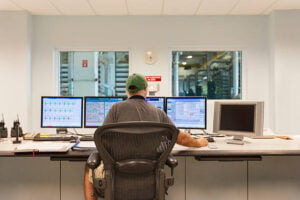Security Change Management:

Consider this: your security staff is overwhelmed by manual approvals, drowning in paperwork, and under continual pressure to deliver essential security updates while minimising downtime. Sounds familiar, right? Manual security change management (SCM) systems are frequently inefficient, time-consuming, and prone to human mistakes. This not only slows down deployments and reduces agility, but it also raises the danger of vulnerabilities falling through the cracks.
Unveiling Security Change Management’s Hero: Automation
Automating important tasks in your security chain management process might be your knight in shining armour. Using automation techniques and technology, you can:
1. Streamline workflows: Eliminate repetitive manual processes such as data entry, approval routing, and documentation. Automation handles these, freeing up your team’s valuable time for more advanced work.
2. Reduce mistakes: Automation removes the need for manual interventions, reducing the likelihood of typos, errors, and missed steps.
3. Increase efficiency and agility: Changes are executed faster and more consistently via automated processes, allowing your team to respond quickly to emerging risks and opportunities.
4. Improve compliance: Automate compliance tests and reporting to ensure conformity to security legislation and standards.
5. Mitigate risks: prioritise and automate key security patches and upgrades to reduce the window of vulnerability.
Read More: Unveiling Tools to Detect and Prevent Phishing Scams
How to Automate Specific Areas of Your Security Change Management Process:

Let’s look at some specific areas where automation can have a huge impact:
1. Change identification and categorization:
Automated security change management solutions can monitor your IT infrastructure and automatically detect changes, categorising them based on risk and impact. This eliminates the need for manual identification, streamlining the approval process.
2. Approval workflows:
Configure automated workflows to route change requests for approval using preset criteria. This ensures that the appropriate individuals are involved, saves time, and removes bottlenecks.
3. Change Deployment and Verification.
Automate the deployment of approved updates using pre-configured scripts and tools. This lowers the need for manual interventions while also ensuring uniformity of execution. Automate post-deployment verification to ensure the modification was successful and that no unforeseen consequences occurred.
4. Documenting and reporting:
Automatically generate complete audit logs and reports on all modifications, making compliance reporting easier and delivering important insights.
5. Vulnerability management:
Automate the vulnerability screening and patching operations, prioritising critical vulnerabilities and deploying patches quickly.
How to Select the Right Automation Tools for Security Change Management:
With so many automation solutions available, selecting the correct one is critical. Consider factors such as:
1. Your unique demands and problems
2. Integration with current systems and tools.
3. Easy to use and scalable.
4. Security and compliance features.
5. Vendor support and expertise
A Step-by-Step Guide for Effective Security Change Management with Automation
1. Evaluate your present SCM process. Determine bottlenecks, time-consuming tasks, and places prone to error.
2. Define your automation goals. What do you hope to achieve with automation?
3. Evaluate your current infrastructure and tools. Determine compatible solutions and potential interconnection sites.
4. Research and choose automation tools. Consider your requirements, budget, and technical expertise.
5. Begin small and grow gradually. Implement automation in stages, beginning with low-risk areas and gaining experience.
6. Train your team and offer continuing support. Ensure that everyone knows automated procedures and how to use them successfully.
7. Continue to watch and adjust: Evaluate the impact of automation, find areas for improvement, and adjust as necessary.
Read More: How to Implement a Change Management Process for Network Security
Exploring the Wider Benefits of Automation for Effective Security Change Management

While increased efficiency is a significant advantage, automation in SCM offers greater benefits.
Enhanced security posture: By automating important tasks and minimising human error, you can greatly minimise the likelihood of vulnerabilities and breaches.
Increased employee satisfaction: Eliminating boring duties allows your team to concentrate on strategic goals and professional development.
Data-driven decision-making: Automated processes produce important data that may be used to influence security decisions and risk management methods.
Cost reductions: Automation decreases manual workload, resulting in higher productivity and long-term cost savings.
Automating Security Change Management: Challenges and Opportunities
While automation has substantial benefits, deploying it effectively in security change management poses its own set of challenges.
1. Resistance to Change: Traditional IT staff may be content with their established, familiar manual methods and hesitant to accept new automated technologies. Addressing concerns, offering training, and demonstrating the value of automation are critical.
2. Complexity of Integration: Integrating automation technologies with current IT infrastructure and security solutions can be difficult and necessitate technical knowledge. Ensuring seamless integration and data compatibility is critical.
3. Security Concerns: Introducing new software and technologies has inherent security concerns. It is vital to thoroughly assess vendors, select credible solutions with strong security features, and put in place suitable access controls.
4. Skill Gap: Effective use of automation tools frequently necessitates the acquisition of certain technical skills. Invest in training and upskilling your team so that they can properly manage and maintain automated operations.
5. Cost considerations: While automation can result in long-term cost benefits, the initial investment in tools, training, and implementation can be significant. Careful cost-benefit analysis and staggered implementation are critical.
Read More: Unveiling Privacy Tools to Combat Online Snooping
The Future of Security Change Management Solutions:

Manual SCM techniques are just ineffective in today’s dynamic and demanding security context. Organisations that embrace automation can increase productivity, reduce risks, and develop a more robust security posture. As automation technology advances, we may anticipate even more revolutionary opportunities for security change management.
Here are some exciting glimpses of the future:
1. Artificial Intelligence (AI) and Machine Learning (ML):
AI and ML systems can analyse massive volumes of data to forecast possible security threats, identify the best change implementation tactics, and even respond autonomously to low-risk changes. Consider an AI-powered system that learns from previous change experiences, proactively identifies potential vulnerabilities, and recommends safe change paths, freeing up human teams to make more strategic decisions.
2. Self-Healing Infrastructure:
Consider an IT infrastructure that detects and resolves security issues without human interaction. This future promises self-healing networks that constantly learn and adapt, automatically delivering updates and establishing security controls to counteract emerging threats in real-time.
3. Continuous Integration and Continuous Delivery (CI/CD) for Security:
Integrating security processes into CI/CD pipelines helps speed up secure deployments and upgrades while reducing the window of vulnerability. Automation tools may effortlessly integrate security checks and approvals into the CI/CD pipeline, resulting in a continuous and secure development environment.
4. Blockchain-based Change Management:
Blockchain technology, known for its immutability and transparency, has the potential to safeguard and streamline change management procedures. Consider an auditable, tamper-proof record of all modifications made, empowering compliance and building confidence among stakeholders.
5. Collaborative Automation Across the Security Ecosystem:
The future of automation extends beyond individual tools. Imagine a collaborative environment in which automation technologies from many vendors smoothly integrate and share data, resulting in a comprehensive, automated security response across the organisation.
Conclusion:
Automating security change management can improve efficiency, reduce risks, and strengthen the security posture. While hurdles exist, proper planning, stakeholder buy-in, and a phased approach can pave the road for effective deployment and realising automation’s full potential. Remember that automation is not a replacement for human expertise but rather a useful tool for empowering your security team and streamlining operations to ensure a more secure future.
Embracing these improvements necessitates proactive investment in talent development, security awareness, and an innovative culture. However, the benefits are significant: a future in which security seamlessly interacts with business operations, risks are proactively reduced, and organisations can confidently and quickly react to an ever-changing threat landscape. So, are you prepared to embrace automation and seize the future of security change management? The moment to start is now.










